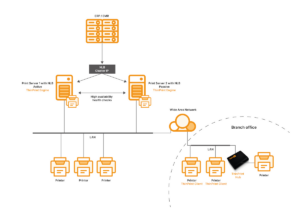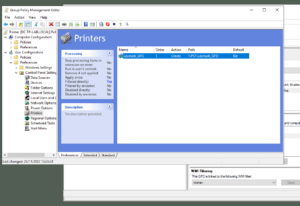Reduce printing costs and resources

Companies are increasingly changing up a gear and replacing their less-attractive data centers with Microsoft Azure, Amazon Web Services or an independent, experienced managed services provider. With a virtual private cloud, companies gain far more flexibility, allowing planning for both short and long-term needs. Resources can be tailored to current demands, resulting in costs being kept under control. Changing your data center is the perfect opportunity to take a closer look at how to enable printing and reduce printing costs associated with it.
In a series of blog entries, I’m outlining the 5 most important benefits from changing. Part one is titled: “IT (and printing as part of that) is a service, services are not run on user’s devices”. While the subject of the second article is: “Printer Drivers: The Fewer the Better“.
In this part, I want to focus on how to save IT resources and reduce printing costs by treating the printing process like a private cloud service that is centrally run and managed.
Printing needs resources to be available in case large numbers of users print at the same time. Because the most resource-intensive processes happen close to the application, they need to be located directly where the users’ applications are run. In virtual/remote desktop environments, this is usually on expensive, private-cloud servers in the environment running the users’ desktops. Roughly 20% of a server’s capabilities need to be set aside for printing – just in case they are needed. With ThinPrint, very little of the print processing takes place on the private-cloud servers where the users’ desktops and applications are running. Most of this happens on one or more dedicated ThinPrint Server. These servers fulfill a highly-defined role with very specific resource use. This helps to save resources and reduce printing costs. Using server virtualization in combination with ThinPrint’s high availability and load balancing features means that during times of low print volume, only a minimum amount of resources are actively running while ThinPrint Servers are constantly monitored to detect when they reach capacity.
This concept not only allows a greater number of users to utilize expensive server resources in a highly-efficient way. It also allows precise, effective deployment of just the right amount of resources needed for printing. This allows hardware resources to be utilized for only as long as they are needed. Other factors to consider include the number of helpdesk calls for printing, which are a significant burden on companies as they not only tie down the employee facing the issue, but also the member of the IT department trying to resolve the problem. With ThinPrint, print-related helpdesk calls are typically reduced by 80% and the recently introduced Printer Self Service Portal will reduce this number even further. It does so by providing a higher-quality user experience as users themselves are more easily able to resolve issues on their own, or simply find the printer they are looking to use.
What also needs to be considered is the amount of bandwidth used for printing – which typically is a lot. This is taxing even for higher-bandwidth connections. ThinPrint reduces the amount of bandwidth needed for printing by up to 98%.
And last but not least, security breaches are extremely expensive for an organization, and like many other areas, printing is a point of entry to your environment. ThinPrint encrypts print jobs, and also offers pull printing. This ensures that print jobs are only released once the user has authenticated directly at the printer, ensuring sensitive information never falls into the wrong hands. In summary you can see that a wide range of topics and issues influence the costs related to printing. ThinPrint, with its many years of experience in the area, offers highly-reliable solutions that bring back down the cost of printing.




